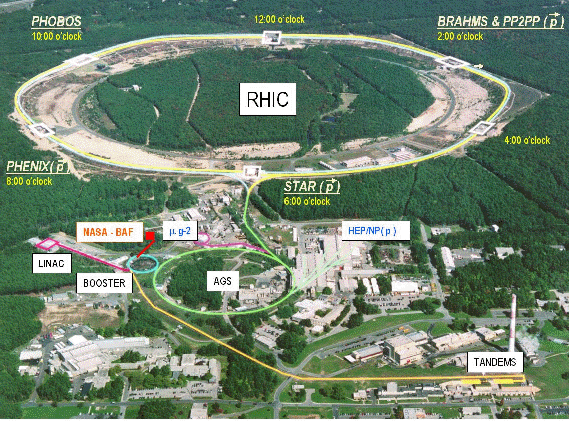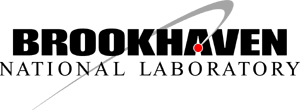


COLLIDER-ACCELERATOR DEPARTMENT
"NEWSLETTER"
January 2000
| WELCOME to
the first issue of our Collider-Accelerator Department newsletter.
We hope that you find the newsletter not only informative but
fun.
We need a name for our "newsletter". Please send your suggestion to me (lopresti@bnl.gov) and then we'll put it to a vote. After all "this is OUR newsletter". How will we make this fun? Well, that will take YOUR input. Any news that you have pertaining to our department or personnel is appreciated. For example: length of BNL employment anniversary, birthdays, weddings, new births, retirements, "gossip". It's up to you - it's YOUR newsletter; just send your input to me. Remember - Only YOU can make this work! Penny Lo Presti |
|
|
I would like to first thank Penny Lo Presti for coming up with the idea of a department newsletter, and then making it happen. This hopefully will allow all of us to keep in touch over our sprawling enterprise. We are members of the single largest department or division at BNL, and are spread over a vast number of buildings. As we start the new year, we find the department in a growth situation. The merger of the RHIC Project and the AGS Department forced us to reduce staff. This is never a happy situation, but the voluntary actions of our colleagues, made it a lot easier one to handle. Fortunatley for us, several of our alumni still come to work. THANK YOU! The departments focus is clearly upon RHIC and the upcoming running period. We are still active in high energy physics. The g-2 experiment is running and the future of the SEB program, both HEP and NP, looks much better for FY01 and beyond. there are various studies going on about future projects, such as a muon collider and a muon storage ring as a neutrino source. the NASA program is expanding, with a second run likely this summer and the start of BAF construction this past November. The BES and DP experiments are also expected to expand this year. In addition we have begun to look at other possibilities beyond today's RHIC. The first Siberian Snake has been installed in RHIC for the spin program. The new OPPIS source, from KEK and TRIUMF, has been delivered and is being installed. There is work going on about a possible electron beam option in RHIC as well as significant heavy ion luminosity upgrade options. The EBIS heavy ion source has started beam tests. This device will provide beams with mass up to that of uranium. Inthe medical area we are involved in the construction of an accelerator-based BNCT facility, the design of a cyclotron based isotope production facility and a rapid cycling synchrotron for radiation oncology. Last, but not least, we are responsible for the design and construction of the SNS accumulator ring, which is to be sited at ORNL. It is a busy and exciting time, and I am certain that the Collider-Accelerator Department will uphold the great tradition of our predecessor accelerator departments. Derek Lowenstein |
|
|
Administration We have started the process of Budget Trim #2. This trim, which will be completed in January will form the basis of the FY2002 laboratory budget submission to the DOE for the C-A Department. A memo giving the approval process for ILR's and Purchase Requisitions was issued on Dec. 22. We will modify the process as necessary to fill our requirements. A list of "who is doing what" in the Administrative Group is being created as a reference tool, for those who may have questions. This will be issued soon, if things ever calm down. John Hauser
BAF - Booster Applications Facility
The Booster Applications Facility if alive and well!! A critical construction milestone for this new experiment facility for the NASA space program was completed this past Autumn. The penetration into the AGS Booster D superperiod region for beam extraction was finished during the maintenance period between the Proton Radiography and NASA Radiobiology runs at the AGS. The DOE with the support of NASA conducted a cost, schedule and management review of the project during the first week of December and the results were positive. The total project cost is estimated to be $33,100,000 and it will take two and one half years to complete. The upgrade of the MP6 Tandem Van de Graaff accelerator was completed at the end of December and is now being commissioned. This machine will be used t deliver heavy ions t BAF during RHIC operations and can also be used as a back-up injector for RHIC if MP7 is down. A. McNerney
Access Controls Group During the month of December the STAR experiement Flammable Gas Detection System was completed. This gave the STAR experiment the ability to conduct cosmic ray experiments with P10 gas in their detector. The necessary re-certification of the PASS system was completed in preparation for the g-2 experimental run during December. The process of re-certifying the RHIC Oxygen Deficiency Hazard (ODH) system was started in December. This includes replacing the ODH sensors and performing the required calibration. In January we plan to complete the RHIC ODH system re-certification for cool-down and start the process of re-certifying the PASS for RHIC beam activity in March. We will complete the installation of the CATV system at RHIC. With the CATV system MCR will be able to do remote access into the RHIC tunnel. N. Williams Beam Components and Instrumentation Our work continues in the major areas including operations and g-2 run. The J10 dump remote controls are nearly complete but required a shutdown for completion and testing. For RHIC, we plan to install the beam scraper in mid-January. The movable BPM has a similar motor drive system and will be installed shortly after the scraper. The group will have a large amount of effort directed at the RHIC loss monitors. This work includes repositioning and adding new detectors, pulling new cables, correcting electronic problems, threshold testing, database work, and a host of other details. Also at RHIC< work will continue on solving problems with the beam current transformers and R&D on the AC dipole. And finally, another top priority the completion of the MP6 bypass instrumentation by the end of January. G. McIntyre Experimental Support and Facilities Division Since October 1 of last year, the support of experiments at RHIC and the AGS has been fully integrated into one division (ES&F). Of course, the cooperative process began many years ago, and the changes on October 1st basically served to make this integration administratively clear. The largest component of the Division is the Facilities and Experimental Support Group (a clever recycling of words) under Al Pendzick. This group of engineers and technicians with guidance on scientific issues from the Division physicists, works with experimental teams to plan, construct, modify, and maintain experimental facilities at RHIC and the AGS. There is significant overlap with the Accelerator Division in that many of the services required by the Accelerator Division such as survey, water systems, rigging, electrical and communications are supplied through the ES&F Division. Reciprocally, many aspects of experimental support, eg. E821 itheg-2 experiment) required major efforts on the part of the Accelerator Division late this year. All of the experiments were in place for last summer's run at RHIC, but extensive work was needed to bring the detectors to near completeness. The largest single effort has been to bring the PHENIX detector gas systems and associated safety systems to a state of readiness. There are two facilities being built for tests with fast beams into the East Experimental Area. One will study issues connected with production of muons for future muon colliders. The other will provide a facility for testing production targets for neutron spallation sources in the United States, Japan and Europe. Initial planning is under way for an extensive program for FY2001 and beyond at the AGS. E949 is planned for then, and two medium energy nuclear physics experiments are likely. Of course, E821 will continue. In support of NASA at BAF, and the national SNS, this Division has provided beam design, experimental layouts, and magnet design and prototyping. In conclusion, a wide variety of interesting projects which required big efforts on everyone's part. Alan Carroll Linac Right now the Linac is in full operational mode delivering beam to both BLIP and the Booster. BLIP is making isotopes for patients and Booster and AGS for g-2 HEP running. We are in the process of building a new beam line and source in the front end of Linac for Polarized Protons. This will be the increased intensity polarized source to do SPIN studies in RHIC. B. Briscoe Preinjector Group At the Linac, a new polarized H-minus ion source has arrived and is being installed in the low energy beam transport line before the H-minus RFQ. This source is from KEK, but has come via TRIUMF, where it was upgraded to produce in excess of 1mA of polarized H-minus. This is a factor of 25 higher current than produced in our old BNL polarized source (PONI-1). Anatoli Zelenski (INR and TRIUMF), ne of the world's experts on this type of polarized source, is at BNL leading the installation of the new source. Several other source experts from INR-Moscow have also been here helping with installation. The old polarized RFQ, built at BNL and the first RFQ to ever be used operationally as a preinjector, has now been decommissioned. At the Tandem there is a lot of activity, with help from many C-A Department groups, as steady progress is being made on the MP6 upgrade and the installation of the bypass line. This will provide a backup to MP7 for RHIC operation, as well as allowing the outside user program at the Tandem to continue using MP6, while beam is supplied for RHIC from MP7. The MP6 Tandem should be closed this week for leakage testing. All dipole and quadruple magnets are in place for the bypass line, and the vacuum work, power supply hookup, controls and diagnostic work, etc are in progress. Very good progress has been made recently on the EBIS source test stand. We have transported a pulsed electron beam current of up to 11A through the EBIS trap, exceeding the design goal for 10A. In addition, we have successfully produced ions from background gas in the source, extracting an ion pulse with a peak current in excess of 3mA. The ion yield has scaled as expected with electron beam current. Within the last two weeks, we have completed the installation of anew ion extractor and transport lie to a time-of-flight detector. Last week ions were transported with good efficiency to a Faraday cup 1 meter from the source. We should begin making charge state distribution measurements on the extracted beams from the EBIS very soon. J. Alessi Vacuum Systems December was a very busy month for C-A Vacuum Group staff. We began pumping down and leak checking some of the newly repaired RHIC arc insulating vacuum volumes. Approximately 50% of these volumes are under reasonably good vacuum at the moment. A paper on RHIC vacuum was presented at EVC-6. Beam pipes at Phenix IP section was successfully basked. The g-2 ring vacuum was restored and a few times following kicker and trolley repairs. The SNS Diple chamber RFQ eas completed and a potential vendor was visited. We expect to plane the order with the low bidder in early Jan. A residual gas analyzer with a remote RF unit ws ordered for SNS and will be installed in the Booster ring and evaluated for use n a high radiation area. The remote RF unit can also be a direct replacement/upgrade for the Booster residual gas analyzer system. The evaluation of several commercially available quick disconnect vacuum flanges for use in SNS and Booster is in progress. Preliminary design work, cost estimates and scheduling for BAF is ongoing. In welcoming the new millennium, we will complete all the RHIC vacuum systems ready for cool down and machine commissioning. Another SNS redesign and cost review will certainly keep us very busy. H. Hseuh
|
|
|
Water Systems We are still waiting for funds to proceed with construction of a new SEM cooling system. A Conceptual Design Reprot for a 70 MeV cyclotron is currently being prepared which we are currently involved in. Design work is progressing for cooling system for the BAF Project. Drawings have been forwarded to Plant Engineering to upgrade the Tandem cooling system and drawings are being prepared for an upgrade to the Westinghouse cooling system. Ed Dale SNS Project This five-laboratory collaboration for the Spallation Neutron Source (SNS) began in FY 1996 for a three-year R&D period to complete the conceptual design. The project was approved by the U.S. Congress in FY 1999 for construction to be completed in FY 2005. The total project cost is about 1.36B$, including R&D, accelerator systems, target and instruments, conventional facilities, and pre-operation. The BNL share of the project is about 150M$ over the lifetime of the project. At its peak, the BNL construction will involve about 100 people. Although the management of the SNS effort at BNL is through the newly established Collider-Accelerator Department, the staff also includes people from NSLS, DAT, Physics, Instrumentation and Plant Engineering. A BNL project office in Bldg. 817 has been established to provide a centralized design effort and better communication among the BNL staff and with the participating laboratories. In FY1999 we have actively participated in the ORNL project office’s effort of project assessment and design optimization. The C-A accelerator physics group completed a comparative study of an accumulator ring and rapid cycling synchrotron options in record time and clearly delineated the pros and cons of both approaches. The original choice of an accumulator ring was endorsed by an independent expert group on its merits of less beam losses, better reliability, and lower cost. On Dec. 6-8 there was an Accelerator System Advisory Committee (ASAC) meeting at BNL to review the physics design of the SNS accelerator complex. BNL reported on its progresses in ring lattice design, beam losses and collimation, impedances and instability, rf beam loading compensation. Our efforts were endorsed by the committee. They also mentioned that we have a proper mix of senior and young physicists which work together coherently and would be capable of solving future problems. On December 15 a groundbreaking ceremony for SNS was held at ORNL with Vice President Al Gore as guest of honor speaker. All five participating laboratory directors or representatives were also present. Currently the SNS project is studying the feasibility of superconducitng linac and 1.3 GeV accumulator ring. The final decision will be made in time for a March DOE review.
Major areas of work in FY2000 are the completion of prototype magnets, rf cavity, kickers, foil support and initiation of major procurements. Detailed definition of the power, water, and utilities for conventional facility is crucial for the construction schedule. To facilitate the BNL effort and national collaboration, the BNL director has established an oversight group at BNL which will meet monthly to monitor the progress of the project and help resolve any issues encountered by the team. W. T. Weng FAREWELL The Department said farewell to the following employees in December. Z. Armoza A. McGearyV. Chiampou J. Makoulis G. Danby E. Onillon G. DeGregory T. Robinson R. Horton B. Stepnosk We wish them all good health and happiness.
DID YOU KNOW????? Melanie Covitz has taken a
position in Staff Services and we wish her well in her new position.
|
|
 JANUARY 2000
JANUARY 2000
|
Saturday 1 |
||||||
| Sunday
2 |
Monday
3 |
Tuesday
4 Time Meeting 1:30 |
Wednesday
5 |
Thursday
6 |
Friday
7 |
Saturday
8 |
| Sunday 9 |
Monday 10 |
Tuesday 11 Time Meeting 1:30 |
Wednesday 12 |
Thursday 13 |
Friday 14 Time Cards Due! |
Saturday 15 |
| Sunday 16 |
Monday 17 Holiday |
Tuesday 18 Time Meeting 1:30 |
Wednesday 19 |
Thursday 20 |
Friday 21 |
Saturday 22 |
| Sunday 23
|
Monday 24
|
Tuesday 25 Time Meeting 1:30
|
Wednesday 26
|
Thursday 27
|
Friday 28
|
Saturday 29 |
| Sunday 30 |
Monday 31 |